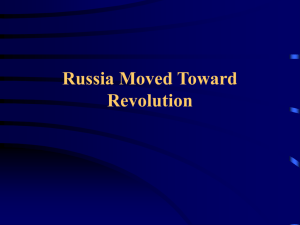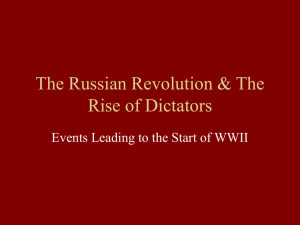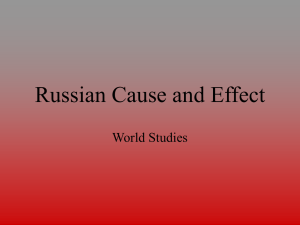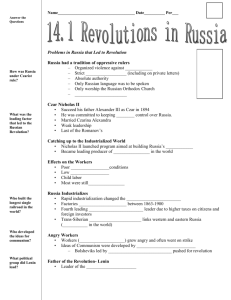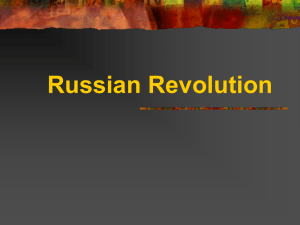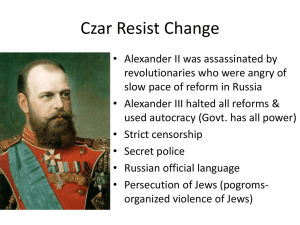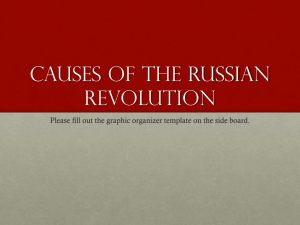30.1 PPT - Ms. Paras
advertisement
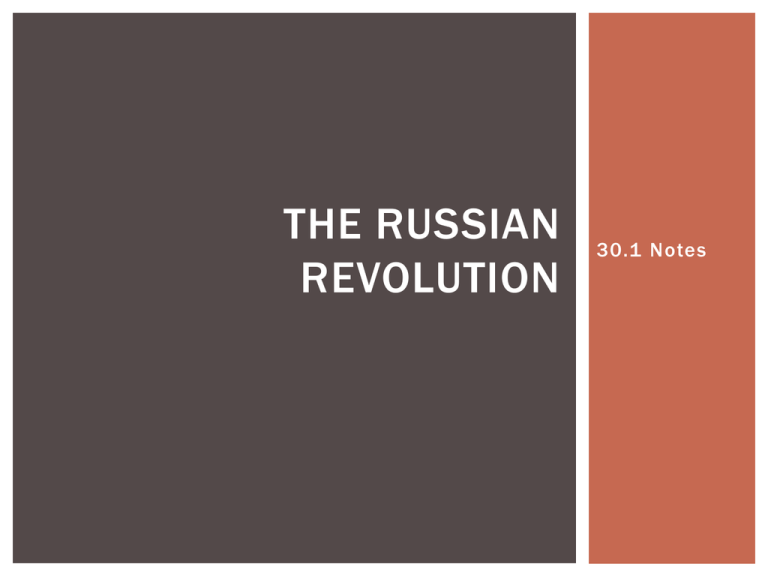
THE RUSSIAN REVOLUTION 30.1 Notes OPENING QUESTION When is it ok for a people to revolt against their government? SETTING THE STAGE: CZARS RESIST CHANGE 1 881 Alexander III succeeded his father as Czar Alexander III believed in autocracy: form of gov’t where he had total control; one per son has absolute control He used har sh measures to wipe out revolutionaries : strict censor ship codes, secret police monitored schools, political prisoners sent to Siberia Est a uniform Russian culture: Russian made of ficial language, o ppressed other groups, targeted Jews in pogroms: organized violence against Jews Nicholas II became czar in 1 894, continued Russian autocracy RUSSIA INDUSTRIALIZES Rapid industrialization changed Russian economy # of factories doubled between 1863-1900; still lagged behind other industrial nations in Europe though 1890s Nicholas II launched program to move country forward Gov't sought foreign investors, raised taxes=boosted growth of heavy industry 1900: Russia was world’s 4 th ranking producer of steel Trans-Siberian Railway: world’s longest continuous rail line, began in 1891 completed in 1916: connected European Russia in West to Russian ports on the Pacific Ocean in the East-helped by British and French investors TRANS-SIBERIAN RAILWAY THE REVOLUTIONARY MOVEMENT GROWS Rapid industrialization stirred discontent because of working conditions, low wages, child labor, etc. Gov’t outlawed unions, workers organized strikes As a result several revolutionary movements grew and competed for power Group that followed Karl Marx’s views established a successful following-these Marxist revolutionaries believed the proletariat(workers) would overthrow the czar, rule the country THE BOLSHEVIKS AND LENIN 1903 Russian Marxists split over tactics: more moderate Mensheviks wanted broad base of popular support for the revolution vs more radical Bolsheviks: supported a small number of committed revolutionaries willing to sacrifice everything for change. Leader of Bolsheviks was Vladimir Ilyich Ulyanov aka Lenin: engaging personality, excellent organizer, ruthless; early 1900s fled to Western Europe to avoid arrest , waited until he could safely return CRISIS AT HOME AND ABROAD 1904-1917 Russia faced series of crises that paved way for revolution The Russo-Japanese War Late 1800s Russia and Japan competed for control of Korea, Manchuria They signed agreements but Russia broke them=war; Japan won series of battles in Feb 1904, sparked unrest and revolt in Russia BLOODY SUNDAY: THE REVOLUTION OF 1905 Jan 22, 1905 about 200,000 worker s and families approached Czar’s Winter Palace in St. Petersburg, asked for better working conditions, freedoms, national legislature Soldiers fired in to crowd, 1 ,000+ wounded, several hundred killed. Prompted nationwide strikes and more violence. Oct 1905 Nicholas II promised more freedom, approved creation of the Duma: Russia’s fir st parliament. Nicholas II dissolved it af ter 10 weeks WWI: THE FINAL BLOW 1914 Nicholas II entered Russia into WWI: unprepared militarily and economically: 4 million causalities in 1 st year! 1915 Nicholas moved his headquarters to war front in hopes of rallying troops left his wife, Czarina Alexandra, in charge she ignored chief advisors, fell under influence of Rasputin: “holy man” who claimed to have magical healing powers Rasputin took care of Czar’s son Alexis, who was a hemophiliac in exchange Alexandra allowed Rasputin to make key political decisions RASPUTIN He opposed reform measures, gave gov’t positions to friends 1916 grp of nobles murdered Rasputin because feared his increasing role in gov’t af fairs Russian soldiers began mutinying, deserting, shortages on everything, people wanted change, end war THE MARCH REVOLUTION March 1917 women textile wrkers in Petrograd led citywide strike, riots over shortages, 200,000 wrkers yelling “ Down with the war” and “Down with the autocracy ”; soldiers at first obeyed orders to shoot them, but later sided with them The local protest spread to became general uprising known as the March Revolution, forced Czar Nicholas II to abdicate, or give up, throne THE MARCH REVOLUTION CONT’D Leaders of the Duma set up a provisional government: temporary gov’t led by Alexander Kerensky -his decision to continue fighting WWI lost support of people Peasants demanded land, socialist revolutionaries formed soviets: local councils consisting of wrkers, peasants, and soldiers; in some cities soviets had more influence than the gov’t THE BOLSHEVIK REVOLUTION Germans believed Lenin could stir up trouble, force Russia to leave WWI, so they arranged for his return in April 1917 Lenin and Bolsheviks took control of Petrograd soviet , and soviets in other cities • Fall of 1917 people were rallying to call: “All power to the soviets” and Lenin’s slogan: “Peace, Land, and Bread” • The Provisional Government Topples • Nov 1917 armed factory workers stormed Winter Palace in Petrograd, called themselves the Bolshevik Red Guards, they took over gov’t offices, arrested gov’t leaders BOLSHEVIKS IN POWER Within days Lenin ordered all farmland to be distributed to peasants, gave control of factories to workers, and signed truce with Germany March 1918 Russia and Germany signed Treaty of Brest-Litovsk: Russia surrendered large part of territory to Germany and allies Russian people angry about this, blamed Bolsheviks CIVIL WAR RAGES IN RUSSIA 1918-1920 civil war in Russia: Red Army of Bolsheviks, led by Leon Trotsky, vs White Army (many dif ferent grps, some supported czar, some democratic govt, others socialists against Lenin) supported by US and western nations About 14 million Russians died in the three year struggle and famine that followed Russia in chaos-in end Red Army wins LENIN RESTORES ORDER: NEW ECONOMIC POLICY Russian economy destroyed by war and revolution -Lenin focused on this and restructuring gov’t March 1921 Lenin temporarily put aside his plan for a state controlled economy His plan was small-scale version of capitalism called the New Economic Policy(NEP): allowed peasants to sell surplus crops instead of turning over to gov’t, some small factories, businesses and farms allowed to operate under private ownership, gov’t encouraged foreign investment Gov’t kept control of major industries, banks, and means of communication Russia slowly recovered, by 1928 back to pre WWI levels POLITICAL REFORMS Bolshevik leaders saw nationalism as a threat to unity and par ty loyalty -to keep it in check Lenin organized Russia into several self governing republics under the central gov’t 1922 renamed the Union of Soviet Socialist Republics (USSR) in honor of councils Bolsheviks renamed their par ty the Communist Par ty 1924 Communists created constitution based on socialist and democratic principles In reality, Communist Par ty held all power, Lenin est a dictatorship of the Communist Par t y not a dictatorship of the proletariat as Mar x had promoted

